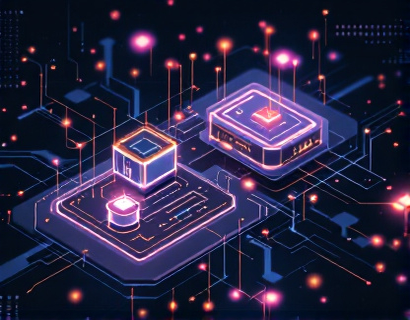Mastering Digital Currency Creation: A Guide to Cutting-Edge Software for Businesses and Blockchain Innovators
In the rapidly evolving landscape of blockchain technology, the ability to create and manage digital currencies has become an essential skill for businesses and innovators. This guide delves into the advanced software tools designed to simplify the complex process of launching and managing digital tokens and currencies. By focusing on unparalleled customization, robust security, and seamless scalability, these tools make blockchain technology accessible and manageable for both novices and experts.
Understanding Digital Currency Creation
Digital currencies, often referred to as cryptocurrencies, operate on blockchain technology, a decentralized ledger that ensures transparency, security, and immutability. Creating a digital currency involves several steps, from designing the token's specifications to deploying it on a blockchain network. The process can be daunting, but with the right software, it becomes a streamlined and efficient task.
Key Features of Advanced Digital Currency Software
Advanced software for digital currency creation offers a suite of features that cater to the diverse needs of businesses and blockchain enthusiasts. These features include:
- Customizable Token Parameters: Define the number of tokens, distribution methods, and burning mechanisms.
- Robust Security Protocols: Implement advanced cryptographic techniques to ensure the integrity and security of the currency.
- Seamless Integration: Easily integrate the currency with existing blockchain platforms and applications.
- Scalability Options: Design the currency to handle increasing transaction volumes without performance degradation.
- User-Friendly Interfaces: Intuitive dashboards and tools for managing and monitoring the currency.
Customization Options
One of the most significant advantages of using advanced software is the level of customization it offers. Users can tailor the digital currency to meet specific business goals and requirements. This includes:
Defining Token Economics: Set parameters such as total supply, inflation rate, and distribution schedules to create a balanced and sustainable economy.
Designing Token Utilities: Determine the use cases for the token, whether for transactions, governance, or as a store of value.
Creating Unique Features: Incorporate additional functionalities like staking, rewards, and airdrops to enhance user engagement and value.
Security Measures
Security is paramount in the world of digital currencies. Advanced software implements several measures to protect the currency and its users:
Cryptographic Algorithms: Utilize state-of-the-art cryptographic techniques to secure transactions and prevent fraud.
Smart Contract Audits: Conduct thorough audits of smart contracts to identify and rectify vulnerabilities.
Multi-Signature Wallets: Implement multi-signature requirements for critical operations to add an extra layer of security.
Regular Updates: Provide ongoing updates to address new threats and enhance security protocols.
Scalability and Performance
As the number of users and transactions grows, the digital currency must scale efficiently without compromising performance. Advanced software addresses this challenge through:
Sharding: Divide the blockchain into smaller, manageable parts to increase transaction processing speed.
Layer 2 Solutions: Implement off-chain transactions to reduce network congestion and lower fees.
Dynamic Fees: Adjust transaction fees based on network conditions to maintain optimal performance.
High Availability: Ensure the system remains operational and accessible even under heavy load.
User Experience and Management
For both businesses and individuals, managing a digital currency should be straightforward and intuitive. Advanced software provides:
Dashboard Overview: Real-time monitoring of key metrics such as token supply, transactions, and user activity.
Reporting Tools: Generate detailed reports for analysis and decision-making.
User Onboarding: Simplified processes for new users to understand and start using the currency.
Customer Support: Access to dedicated support for troubleshooting and guidance.
Case Studies and Success Stories
Several businesses and projects have successfully leveraged advanced digital currency software to achieve their goals. For instance, a decentralized finance (DeFi) platform used the software to create a stablecoin with customizable parameters, enabling it to attract a large user base and facilitate seamless financial transactions. Another example is a gaming company that integrated a utility token into its ecosystem, enhancing player engagement and creating a new revenue stream.
Project A: Decentralized Finance Stablecoin
Project A aimed to create a stablecoin for their DeFi platform. They used the advanced software to define a stablecoin with a fixed supply and pegged to a basket of assets. The software's customization tools allowed them to set dynamic peg adjustments based on market conditions. The robust security features, including smart contract audits and multi-signature wallets, ensured the stability and trustworthiness of the coin. The result was a stablecoin that gained widespread adoption, facilitating smooth transactions and attracting significant investment.
Project B: Gaming Utility Token
Project B, a gaming company, sought to create a utility token to enhance user engagement and reward in-game achievements. Using the software, they designed a token with unique utilities such as in-game purchases, access to exclusive content, and staking rewards. The user-friendly interface and comprehensive reporting tools helped them manage the token effectively. The token's success led to increased player retention and a vibrant community, driving the overall growth of the gaming platform.
Getting Started with Digital Currency Software
For businesses and blockchain innovators looking to enter the digital currency space, the following steps can guide them in selecting and utilizing advanced software:
- Identify Requirements: Clearly define the goals and specific needs for the digital currency.
- Research Software Options: Explore different software solutions, considering factors like customization, security, and scalability.
- Prototype and Test: Create a prototype using the software and conduct thorough testing to ensure it meets all requirements.
- Deployment and Monitoring: Deploy the currency on the blockchain and continuously monitor its performance and security.
- Community Engagement: Build and engage with a community to gather feedback and enhance the currency's value.
Conclusion
Mastering digital currency creation is no longer a task reserved for experts alone. With advanced software, businesses and blockchain innovators can confidently design, launch, and manage their own digital currencies. By focusing on customization, security, and scalability, these tools make blockchain technology accessible and empowering. As the digital currency landscape continues to evolve, staying informed and leveraging the right software will be crucial for success.










































